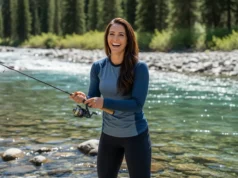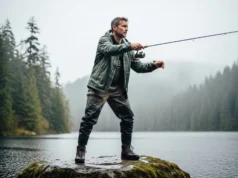In this article
You successfully land the fish, pop the hook, and watch it kick away into the current with vigor. You high-five your buddy, assuming a successful release. But biological reality is often crueler than our assumptions. Research indicates that release mortality frequently occurs 48 to 96 hours after the fish leaves your sight. The culprit is rarely exhaustion; it is the abrasion of the cutaneous mucous layer—the “slime coat”—caused by outdated mesh materials.
I have dragged nets through miles of scrub oak on bank/wade fishing trips and deployed them from kayak cockpits in gale-force winds. I’ve learned that a fishing net is no longer just a basket or basic terminal tackle to secure dinner; it is a portable live well designed for catch-and-release success and to prevent delayed mortality.
If you treat your net as a life-support system rather than a capture device, you change the dynamic entirely. This guide moves beyond generic recommendations to the intersection of conservation science (protecting the slime coat) and mechanical leverage (protecting your wrist). We will explore why “Ghost” rubber mesh is the non-negotiable standard, how handle length dictates torque, and which specialized tool fits your specific environment—from high-deck bass boats to intimate trout streams.
How to Choose the Right Fishing Net
We need to arm you with objective knowledge. You shouldn’t just buy a net; you should select a tool based on biological and physical requirements.
Why Does Mesh Material Matter? (The Science of the Slime Coat)
The most critical component of your net is the mesh netting. A fish’s slime coat is a living immune system, rich in antibodies and antimicrobial peptides that fight off bacteria and parasites. When you drag a fish across knotted nylon, cheap string-style netting, or fine micromesh, the material acts like sandpaper. It strips this protective layer, leaving the fish open to Saprolegnia (fungal) infections days later.
For this reason, molded silicone or rubber “Ghost” mesh is the industry standard for fish management. It is non-porous, prevents hooks from snagging, and causes the absolute lowest amount of scale loss. Independent studies have shown significant differences in injury and mortality rates based on mesh type, confirming that a fish-friendly mesh is essential for survival.
Once we secure the fish’s health by implementing proper catch and release techniques, we must consider the mechanics of the angler’s effort.
How Does Handle Length Affect Leverage? (The Physics of Torque)
A net operates as a Class 3 lever. The further the net hoop is from your hand, the heavier the fish feels. This is the physics of the moment arm: a 10lb fish on a 6ft handle exerts exponentially more torque on your wrist than the same fish on a 2ft handle.
For solo anglers, this leverage physics is critical. You need lighter, stiffer materials like a carbon fiber handle to manage this torque with one hand. Understanding these forces is the prerequisite to safely holding the fish for a photo or de-hooking without dropping it or injuring yourself, helping to minimize forearm strain.
Our Selection Process: How We Built This Guide
We recognize that the “average angler” does not exist; gear must be matched to the operational environment. We evaluated options from major players like EGO, Ranger Nets, and Simms alongside niche manufacturers. Every net in this guide was scored on a 5-point scale across five dimensions: Fish Safety (FS), Ergonomics & Leverage (EL), Durability & Build (DB), Portability (PS), and Value (VP).
We actively looked for failure points. We sought out sticky grips that peel, brittle yoke construction that cracks in the cold, and handles that sink. While we may earn a commission from links here, our primary allegiance is to the biological integrity of the fishery and the longevity of your gear.
The Best Fishing Nets of 2026: Our Top Recommendations for Every Need
Our Top Picks for The Conservation Specialist (Wade & Fly)
These anglers operate on foot in moving water, often targeting trout in tailwaters or small streams. They prioritize weight, “stealth,” and fish safety above all else. A heavy net is a liability when hiking miles of riverbank or wading deep currents. While we respect the craftsmanship of a handmade net or premium options like the Simms Daymaker or Brodin, the picks below offer the best balance of utility and biology.
Our Top Picks for The Boat Captain (Bass, Walleye & Pike)
These anglers deal with high gunwales, limited deck space, and heavy fish. Structural rigidity and reach are critical. A flimsy handle here means a lost trophy. While the EGO S1 Slider and EGO S2 Slider Guide Net are popular for their extendable reach, the picks below focus on heavy-duty durability for big-water muskie fishing and walleye fishing where strength is the priority.
Our Top Picks for The Kayak & Solo Angler
These anglers sit low to the water with limited leverage. Floatation and one-handed operation are requirements, not luxuries. If you can’t lift it with one arm while fighting a fish with the other, it’s useless. Avoid the temptation of a cheap Restcloud telescoping aluminum or a Wakeman retractable rubber model; they often rust in saltwater or sink when dropped.
Conclusion
Conservation is king. If your net isn’t rubber—or at least high-quality coated—you are risking the future of the fish you catch. Physics wins every time; don’t try to use a boat net in a kayak or a wade net from a high deck.
A $150 net that lasts a lifetime and saves 500 fish is infinitely cheaper than a $30 net that breaks in a year and kills 10% of your catch. Stop losing fish at the rail. Upgrade to a tool that matches your specific fishing style and protect the resource for your next trip.
FAQ – Frequently Asked Questions
Why do fish die after being released even if they swim away?
Delayed mortality is often caused by the removal of the slime coat (mucous layer) during netting, leading to osmotic stress and fungal infections days later. Using a Molded Rubber Net significantly reduces this risk compared to knotted nylon.
What is the Zip Tie Hack for fishing nets?
This is a field repair technique where anglers carry UV-resistant zip ties to instantly stitch a torn rubber net bag back to the hoop without ending their trip. It creates a repair often stronger than the original cotton stitching.
Can I use a boat net for kayak fishing?
Generally, no. Long handles on boat nets are unwieldy in a seated position and often lack the floatation required if dropped overboard. Look for specialized nets like the YakAttack Leverage Net designed for low-center-of-gravity use.
How do I clean a rubber fishing net?
Rinse with fresh water after every saltwater use and avoid leaving it in direct sunlight, which causes the rubber to depolymerize (become sticky or brittle). Proper cleaning also prevents invasive species transfer between bodies of water. For more detailed maintenance, read our guide on sustainable fishing gear maintenance.
Risk Disclaimer: Fishing, boating, and all related outdoor activities involve inherent risks that can lead to injury. The information provided on Master Fishing Mag is for educational and informational purposes only. While we strive for accuracy, the information, techniques, and advice on gear and safety are not a substitute for your own best judgment, local knowledge, and adherence to official regulations. Fishing regulations, including seasons, size limits, and species restrictions, change frequently and vary by location. Always consult the latest official regulations from your local fish and wildlife agency before heading out. Proper handling of hooks, knives, and other sharp equipment is essential for safety. Furthermore, be aware of local fish consumption advisories. By using this website, you agree that you are solely responsible for your own safety and for complying with all applicable laws. Any reliance you place on our content is strictly at your own risk. Master Fishing Mag and its authors will not be held liable for any injury, damage, or loss sustained in connection with the use of the information herein.
Affiliate Disclosure: We are a participant in the Amazon Services LLC Associates Program, an affiliate advertising program designed to provide a means for us to earn advertising fees by advertising and linking to Amazon.com. As an Amazon Associate, we earn from qualifying purchases. We also participate in other affiliate programs and may receive a commission on products purchased through our links, at no extra cost to you. Additional terms are found in the terms of service.





